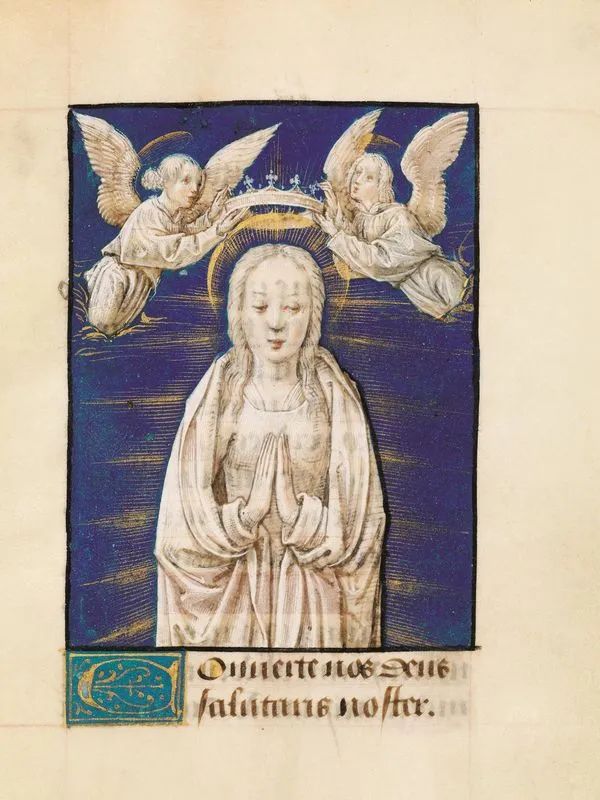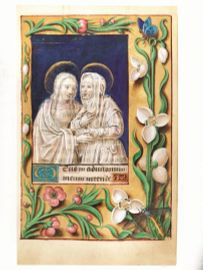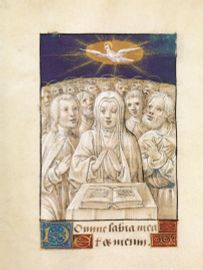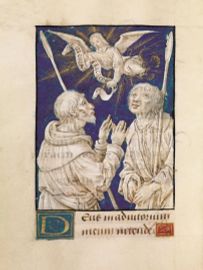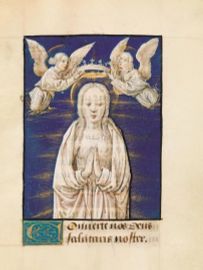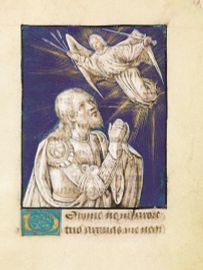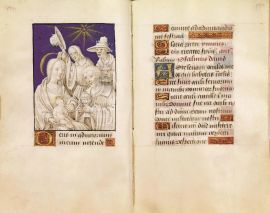LIBRO D'ORE ALL'USO DI TOURS
in latino e in francese
Francia, Tours, c. 1500-1508
MANOSCRITTO MINIATO SU PERGAMENA, in 8vo (173 x 111 mm), [123] carte, numerate 1-247 da mano posteriore (ultima carta bianca). Completo. Specchio di scrittura 97 x 65 mm.
BOOK OF HOURS, USE OF TOURS
in Latin and French
France, Tours, ca. 1500-1508
ILLUMINATED MANUSCRIPT ON VELLUM, 8vo (173 x 111), [123] leaves numbered 1-247 by a later hand (last leaf blank). Complete. Written-space 97 x 65 mm.
Testo su una colonna di 16 righe, in caratteri gotici in inchiostro marrone scuro, con nomi delle sezioni e di alcuni santi nel Calendario in rosso. Numerose iniziali alte una o due linee filigranate in oro su fondo blu o rosso, numerose fasce decorative alte una linea filigranate in oro su fondo rosso. UNDICI GRANDI MINIATURE A PIENA PAGINA con le figure in colore neutro con fini ombreggiature e lumeggiature in bianco, e con dettagli della carnagione in rosa, su fondali blu, e con aureole e raggi di luce in oro, e TRE AMPIE BORDURE FLOREALI POLICROME (bianco, rosso, verde, blu, giallo, rosa e cremisi) su fondo oro, abitate da libellule, farfalle, bruchi, una mosca e una coccinella. Armi presumibilmente coeve miniate a colori alla carta 26v. (Nella miniatura dell’Annunciazione lo scritto al verso della carta si vede attraverso la pergamena, soprattutto in corrispondenza delle figure; questo accade, ma in modo meno evidente, in un paio di altre miniature; due bordure presentano piccole abrasioni agli angoli). Legatura francese di fine Ottocento firmata "Fauconnier" in marocchino rosso riccamente decorato in oro e con fermagli, sguardie marmorizzate, tagli dorati, segnacolo di seta. Custodia cartonata rivestita in tela. Il codice è staccato dalla legatura, che presenta un paio di trascurabili difetti all’interno ma, esternamente, è in ottime condizioni.
INUSUALE E SQUISITO LIBRO D'ORE MINIATO NEL GUSTO DI JEAN BOURDICHON E DAL MAESTRO DI CLAUDIA DI FRANCIA
PROVENIENZA: Il manoscritto è stato miniato a Tours e prodotto per l'uso di quella città, come dimostrano gli incipit delle varie sezioni dell'Ufficio della Vergine e dell'Ufficio dei Morti. Ad ulteriore conferma, il calendario segnala in rosso la traslazione delle spoglie di San Martino, vescovo di Tours, il 4 luglio e l'11 novembre, e le feste di San Gregorio di Tours (7 novembre) e di San Gaziano di Tours (18 dicembre), santi che sono nominati anche nelle Litanie. Stemma non identificato, presumibilmente coevo, miniato alla carta 26v, racchiuso entro ghirlanda di foglie decorata da nastri rossi.
TESTO: Calendario cc. 1-12v; Passione secondo Giovanni cc. 13r-23r; Vangelo cc. 23v-25r; 2 pagine di invocazioni in francese, cc. 25v-26r; Ufficio della Vergine, uso di Tours, cc. 27r-78v, frammiste all'Ufficio dello Spirito Santo (cc. 49v-56r); Salmi Penitenziali, cc. 79r-90r; Litanie dei santi, cc. 90v-96r; Ufficio dei Morti, uso di Tours, cc. 96v-123v.
MINIATURA :L'illustrazione è opera di due miniatori, entrambi seguaci di Jean Bourdichon, uno dei quali è stato identificato come il Maestro di Claudia di Francia.
Jean Bourdichon (1457 ca. – 1521) fu attivo a Tours tra il 1480 circa e l’anno della sua morte. Nel corso di questa carriera quarantennale, fu celebrato pittore e miniatore di corte di quattro re francesi: Luigi XI, Carlo VIII, Luigi XII e Francesco I. Il suo capolavoro, le Grandes Heures d'Anne de Bretagne del 1508, ora conservato alla Bibliothèque Nationale di Parigi (ms. Lat. 9474*), è uno dei più famosi codici miniati francesi ed è anche, all'interno della sua abbondante produzione, l'unica opera che gli sia stata attribuita con certezza. Bourdichon fu allievo di Jean Fouquet (1420 ca. – 1481) e del Maestro del Boccaccio di Monaco, dai quali riprende molti elementi stilistici. Come miniatore, mostra una predilezione per l'oro e per il blu, e nelle immagini devozionali ritrae personaggi con gli occhi pietosamente levati verso il cielo.
Entrambe le caratteristiche si riscontrano nel presente libro d’ore, dove il blu dei fondali e l'oro di aureole e raggi di luce sono, assieme al colore neutro delle figure, i due colori principali. Hanno gli occhi rivolti al cielo in atteggiamento pietoso il pastore a destra nella miniatura alla carta 56v e anche il re David, nella miniatura alla carta 79r. In particolare, il volto del pastore presenta una notevole somiglianza con una figura ritratta alla carta 61v delle Heures de Charles VIII conservate alla Bibliothèque Nationale di Parigi (ms. Lat. 1370*), attribuite a Bourdichon. Questo manoscritto condivide inoltre con il presente libro d'ore una caratteristica affascinante e inusuale: i personaggi ritratti sono disegnati sulla pergamena con fini ombreggiature e con lumeggiature di biacca, sicché risultano di un colore neutro, come fossero statue di marmo. Il colore neutro è delicatamente ravvivato da tenui tocchi di rosa che abbelliscono le labbra, le guance e talora le mani dei personaggi ritratti.
Volti, occhi, labbra, panneggi sono eseguiti con una precisione e una leggerezza straordinarie, proprie di un artista raffinato, capace anche di donare espressività alle sue figure, come nell’incontro tra Maria ed Elisabetta, soffuso di dolcezza, o nelle varie rappresentazioni della Vergine, il cui viso irradia soavità. Sono particolarmente attraenti le miniature che raffigurano l'Adorazione dei Magi e l'Incoronazione della Vergine, circondata da sottilissimi raggi dorati come l’angelo che aleggia su re David in armatura finemente cesellata.
Le prime due miniature – l'Annunciazione (carta 27r) e la Visita di Maria a Elisabetta (38r) – sono incorniciate da bordure floreali policrome che, assieme ad una terza bordura presente alla carta 48r, furono con ogni probabilità eseguite dal Maestro de Claudia di Francia. L'opera di questo miniatore, soprattutto noto per i due piccoli libri di preghiera che realizzò per la regina Claudia (1499 – 1524), prima moglie di Francesco I, è incantevole e rara. Fu apprendista di Bourdichon dal 1498 al 1508 circa, e poi attivo a Tours fino al 1520 circa. Lo stile realistico delle tre bordure, che ritraggono con precisione botanica fiori e insetti, rimanda direttamente a quello di tre pagine delle già citate Grandes Heures d'Anne de Bretagne di Bourdichon, ove alle carte 54v e 27v troviamo la pianta di fragole e la veronica qui raffigurate nella prima bordura, alle carte 22r e 42v il bucaneve e i fiori di pesco della seconda bordura, e alla carta 27r il tralcio di rosa della terza bordura. Sono ritratti assieme ai fiori due farfalle, due bruchi, una mosca, una coccinella e una libellula. I fiori di pesco, identificati come tali nonostante le foglie appuntite, compaiono anche alla carta 37r del manoscritto miniato dal Maestro di Claudia tra il 1510 e il 1515, conservato alla Houghton Library dell’Università di Harvard (MS Typ 252). Secondo Roger S. Wieck, autore della monografia Miracles in Miniature: The Art of the Master of Claude de France, le tre bordure nel presente libro d'ore sono sconosciute alla bibliografia relativa al Maestro di Claudia di Francia.
Soggetti delle miniature:
1. Folio 27r: Annunciazione, 146 x 103 mm (miniatura interna 83 x 63 mm). 2. Folio 38r: Visita di Maria a Elisabetta, 148 x 98 mm (miniatura interna 84 x 62 mm).3. Folio 48r: sola bordura; margine inferiore: 48 x 102 mm; margine esterno: 110 x 10 mm. 4. Folio 49v: Discesa dello Spirito Santo, 83 x 63 mm. 5. Folio 50v: Natività, 83 x 64 mm. 6. Folio 56v: Annunciazioni ai pastori, 82 x 63 mm. 7. Folio 60v: Adorazione dei Magi, 85 x 64 mm. 8. Folio 64v: Circoncisione di Gesù, 85 x 64 mm. 9. Folio 68v: Fuga in Egitto, 84 x 64 mm. 10. Folio 75r: Incoronazione della Vergine, 85 x 63 mm. 11. Folio 79r: re David e l'angelo con le tre frecce, simbolo delle tre punizioni, 84 x 66 mm. 12. Folio 96v: resurrezione di Lazzaro, 85 x 62 mm.
Note:
*Il sito Mandragora.bnf.fr riproduce per intero le Grandes Heures d’Anne de Bretagne (Latin 9474), il sito gallica.bnf.fr le Heures de Charles VIII (Latin 1370).
Bibliografia:
Roger S. Wieck, Miracles in Miniature: The Art of the Master of Claude de France (Morgan Library, 2014)F. Avril, N. Reynaud, D, Cordellier, Les Enluminures du Louvre: Moyen Age et Renaissance (Louvre-Hazan, 2012)
Si ringrazia Roger S. Wieck, curatore e responsabile del dipartimento di manoscritti medioevali e rinascimentali della Morgan Library di New York per aver attribuito le tre bordure al Maestro di Claudia di Francia.
Text on one column of 16 lines, written in dark brown ink in a lettre bâtarde, with the names of the sections and a few saints in the Calendar in red ink. Numerous initials one to 2-lines high, painted in gold on blue or red grounds, numerous one-line decorative bands in gold on red grounds. ELEVEN FULL-PAGE MINIATURES with characters in a neutral colour with shadings and with white lead highlights, their complexion with details in pink, on blue backgrounds and with halos and rays of light in gold, and THREE LARGE FLORAL BORDERS IN COLOUR (white, red, green, blue, yellow, pink and crimson) on gold grounds, containing butterflies, caterpillars, a dragonfly, a fly and a ladybird. Presumably contemporary arms illuminated in colour on f. 26v. (In the miniature of the Annunciation the handwriting on the verso of the leaf can be seen through the vellum, particularly in correspondence with the characters; this also happens in a couple of other miniatures, but in a less evident way; two borders have small scratchings at their corners). End of the 19th century French binding signed "Fauconnier", red morocco richly decorated in gilt and with metal clasps, marbled endpapers, gilt edges, silk bookmark. Slipcase lined with red fabric. The codex is loose from its binding, which has a couple of minor faults inside, but is perfect outside.
UNUSUAL AND EXQUISITE BOOK OF HOURS ILLUMINATED IN THE STYLE OF JEAN BOURDICHON AND BY THE MASTER OF CLAUDE OF FRANCE
PROVENANCE: The manuscript was written and illuminated in Tours for the use of that town, as the incipits of the various sections demonstrate. As a further proof, the Calendar lists in red ink the translation of the body of Saint Martin, bishop of Tours, on 4 July and 11 November, and also lists Saint Gregory of Tours (7 November) and Saint Gatian of Tours (18 December). They all appear in the Litany as well. Unidentified arms, presumably contemporary, illuminated on f. 26v, enclosed within a wreath decorated with red ribbons.
TEXT: Calendar, ff. 1-12v; Passion narrative according to John, ff. 13r-23r; Gospel extracts, ff. 23v-25r; 2 pages with invocations in French, ff. 25v-26r; Hours of the Virgin, use of Tours, ff. 27r-78v, interspersed with the Hours of the Holy Spirit (ff. 49v-56r); Penitential Psalms, ff. 79r-90r; Litany, ff. 90v-96r; Office of the Dead, use of Tours, ff. 96v-123v.
ILLUMINATION: The illumination is the work of two artists, both followers of Jean Bourdichon. One of them has been identified as the Master of Claude de France.
Jean Bourdichon (ca. 1457 – 1521) was active in Tours between ca. 1480 and the year of his death. During this 40-year career, he was a celebrated court painter and illuminator for four French kings: Louis XI, Charles VIII, Louis XII and Francis I. His masterpiece, the Grandes Heures of Anne of Brittany of 1508, now held at the Bibliothèque Nationale in Paris (Ms. Lat. 9474*), is one of the most famous French illuminated manuscripts and it also the only work that has been certainly attributed to him. Bourdichon was the pupil of Jean Fouquet (ca. 1420 – 1481) and of the Master of the Munich Boccaccio, from whom he takes several stylistic elements. As an illuminator, he favours gold and blue and in his devotional images he portrays characters with their eyes mercifully turned to the sky.
Both features appear in the present book of hours, where the blue of the grounds and the gold of halos and ray of lights are the main colours along with the neutral hue of the characters. Two of them have their eyes mercifully turned to the sky: the shepherd on the right in the miniature on f. 56v and King David on f. 79r. In particular, the face of the shepherd looks very similar to that of a character portrayed on f. 61v of the Hours of Charles VIII held at the Bibliothèque Nationale in Paris (Ms. Lat. 1370*), attributed to Bourdichon. This manuscript also shares with the present book of hours an unusual and fascinating feature: the characters are drawn on vellum with fine shadings and with white lead highlights so that they have a neutral hue and look like marble statues. The neutral hue is revived with pale touches in pink that embellish lips, cheeks and sometimes the hands of the characters.
Faces, eyes, lips, draperies are executed with extraordinary precision and lightness, typical of a refined artist who was also capable of rendering his characters’ expressiveness, such as the amiability that permeates the Visitation and the gentleness that always emanate from the visage of the Virgin Mary. The miniatures that represent the Adoration of the Magi and the Coronation of the Virgin are particularly beautiful. In the latter, the Virgin shines with fine gilt rays. These also surround the angel who hovers on King David, who wears a finely chiselled armour.
The first two miniatures – the Annunciation (f. 27r) and the Visitation (f. 38r) – are framed with floral borders in colour that were almost certainly painted by the Master of Claude of France, together with a third border on f. 48r. The work of this artist, who is chiefly known for the two tiny prayer books that he made for Queen Claude (1499 – 1524), first wife of Francis I, is enchanting and rare. He was an apprentice of Bourdichon from circa 1498 to 1508, and then he was active in Tours until circa 1520. The realistic style of the borders, which portray flowers and insects with botanical precision, is reminiscent of pages in the already mentioned Grandes Heures of Anne of Brittany by Bourdichon, where, on f. 54v and f. 27v, can be found the strawberry plant and the speedwell that here appear in the first border, on f. 22r and f. 42v the snowdrop and peach flowers of the second border, and on f. 27r the rose shoot of the third border. Two butterflies, two caterpillars, a fly, a ladybird and a dragonfly are also beautifully portrayed. The peach flowers, which have been identified as such even though they have pointed leaves, also appear on f. 37r of the manuscript illuminated by the Master of Claude of France between 1510 and 1515, kept at the Houghton Library at Harvard University (MS Typ 252). According to Roger S. Wieck, author of the monograph Miracles in Miniature: The Art of the Master of Claude de France, the three borders in the present book of hours are apparently unknown to the bibliography on the Master of Claude of France.
Subjects of the miniatures:
1. Folio 27r: The Annunciation, 146 x 103 mm (inside miniature 83 x 63 mm). 2. Folio 38r: The Visitation, 148 x 98 mm (inside miniature 84 x 62 mm).3. Folio 48r: border only; bottom margin: 48 x 102 mm; external margin: 110 x 10 mm. 4. Folio 49v: Pentecost, 83 x 63 mm. 5. Folio 50v: The Nativity, 83 x 64 mm. 6. Folio 56v: The Annunciation to the Shepherds, 82 x 63 mm. 7. Folio 60v: The Adoration of the Magi, 85 x 64 mm. 8. Folio 64v: The Circumcision of Jesus, 85 x 64 mm. 9. Folio 68v: The Flight into Egypt, 84 x 64 mm. 10. Folio 75r: The Coronation of the Virgin, 85 x 63 mm. 11. Folio 79r: King David and the angel with the three arrows, symbol of the three punishments, 84 x 66 mm. 12. Folio 96v: Resurrection of Lazarus, 85 x 62 mm.
Notes:
*The website mandragora.bnf.fr reproduces the Grandes Heures of Anne of Brittany (Latin 9474) in its entirety, the website gallica.bnf.fr the Hours of Charles VIII (Latin 1370).
We are gratefull to Roger S. Wieck, Curator and Department Head of Medieval and Renaissance Manuscripts at The Morgan Library of New York for attributing the three borders to the Master of Claude of France.
Bibliography:
Roger S. Wieck, Miracles in Miniature: The Art of the Master of Claude de France (Morgan Library, 2014)F. Avril, N. Reynaud, D, Cordellier, Les Enluminures du Louvre : Moyen Age et Renaissance (Louvre-Hazan, 2012)
in latino e in francese
Francia, Tours, c. 1500-1508
MANOSCRITTO MINIATO SU PERGAMENA, in 8vo (173 x 111 mm), [123] carte, numerate 1-247 da mano posteriore (ultima carta bianca). Completo. Specchio di scrittura 97 x 65 mm.
BOOK OF HOURS, USE OF TOURS
in Latin and French
France, Tours, ca. 1500-1508
ILLUMINATED MANUSCRIPT ON VELLUM, 8vo (173 x 111), [123] leaves numbered 1-247 by a later hand (last leaf blank). Complete. Written-space 97 x 65 mm.
Testo su una colonna di 16 righe, in caratteri gotici in inchiostro marrone scuro, con nomi delle sezioni e di alcuni santi nel Calendario in rosso. Numerose iniziali alte una o due linee filigranate in oro su fondo blu o rosso, numerose fasce decorative alte una linea filigranate in oro su fondo rosso. UNDICI GRANDI MINIATURE A PIENA PAGINA con le figure in colore neutro con fini ombreggiature e lumeggiature in bianco, e con dettagli della carnagione in rosa, su fondali blu, e con aureole e raggi di luce in oro, e TRE AMPIE BORDURE FLOREALI POLICROME (bianco, rosso, verde, blu, giallo, rosa e cremisi) su fondo oro, abitate da libellule, farfalle, bruchi, una mosca e una coccinella. Armi presumibilmente coeve miniate a colori alla carta 26v. (Nella miniatura dell’Annunciazione lo scritto al verso della carta si vede attraverso la pergamena, soprattutto in corrispondenza delle figure; questo accade, ma in modo meno evidente, in un paio di altre miniature; due bordure presentano piccole abrasioni agli angoli). Legatura francese di fine Ottocento firmata "Fauconnier" in marocchino rosso riccamente decorato in oro e con fermagli, sguardie marmorizzate, tagli dorati, segnacolo di seta. Custodia cartonata rivestita in tela. Il codice è staccato dalla legatura, che presenta un paio di trascurabili difetti all’interno ma, esternamente, è in ottime condizioni.
INUSUALE E SQUISITO LIBRO D'ORE MINIATO NEL GUSTO DI JEAN BOURDICHON E DAL MAESTRO DI CLAUDIA DI FRANCIA
PROVENIENZA: Il manoscritto è stato miniato a Tours e prodotto per l'uso di quella città, come dimostrano gli incipit delle varie sezioni dell'Ufficio della Vergine e dell'Ufficio dei Morti. Ad ulteriore conferma, il calendario segnala in rosso la traslazione delle spoglie di San Martino, vescovo di Tours, il 4 luglio e l'11 novembre, e le feste di San Gregorio di Tours (7 novembre) e di San Gaziano di Tours (18 dicembre), santi che sono nominati anche nelle Litanie. Stemma non identificato, presumibilmente coevo, miniato alla carta 26v, racchiuso entro ghirlanda di foglie decorata da nastri rossi.
TESTO: Calendario cc. 1-12v; Passione secondo Giovanni cc. 13r-23r; Vangelo cc. 23v-25r; 2 pagine di invocazioni in francese, cc. 25v-26r; Ufficio della Vergine, uso di Tours, cc. 27r-78v, frammiste all'Ufficio dello Spirito Santo (cc. 49v-56r); Salmi Penitenziali, cc. 79r-90r; Litanie dei santi, cc. 90v-96r; Ufficio dei Morti, uso di Tours, cc. 96v-123v.
MINIATURA :L'illustrazione è opera di due miniatori, entrambi seguaci di Jean Bourdichon, uno dei quali è stato identificato come il Maestro di Claudia di Francia.
Jean Bourdichon (1457 ca. – 1521) fu attivo a Tours tra il 1480 circa e l’anno della sua morte. Nel corso di questa carriera quarantennale, fu celebrato pittore e miniatore di corte di quattro re francesi: Luigi XI, Carlo VIII, Luigi XII e Francesco I. Il suo capolavoro, le Grandes Heures d'Anne de Bretagne del 1508, ora conservato alla Bibliothèque Nationale di Parigi (ms. Lat. 9474*), è uno dei più famosi codici miniati francesi ed è anche, all'interno della sua abbondante produzione, l'unica opera che gli sia stata attribuita con certezza. Bourdichon fu allievo di Jean Fouquet (1420 ca. – 1481) e del Maestro del Boccaccio di Monaco, dai quali riprende molti elementi stilistici. Come miniatore, mostra una predilezione per l'oro e per il blu, e nelle immagini devozionali ritrae personaggi con gli occhi pietosamente levati verso il cielo.
Entrambe le caratteristiche si riscontrano nel presente libro d’ore, dove il blu dei fondali e l'oro di aureole e raggi di luce sono, assieme al colore neutro delle figure, i due colori principali. Hanno gli occhi rivolti al cielo in atteggiamento pietoso il pastore a destra nella miniatura alla carta 56v e anche il re David, nella miniatura alla carta 79r. In particolare, il volto del pastore presenta una notevole somiglianza con una figura ritratta alla carta 61v delle Heures de Charles VIII conservate alla Bibliothèque Nationale di Parigi (ms. Lat. 1370*), attribuite a Bourdichon. Questo manoscritto condivide inoltre con il presente libro d'ore una caratteristica affascinante e inusuale: i personaggi ritratti sono disegnati sulla pergamena con fini ombreggiature e con lumeggiature di biacca, sicché risultano di un colore neutro, come fossero statue di marmo. Il colore neutro è delicatamente ravvivato da tenui tocchi di rosa che abbelliscono le labbra, le guance e talora le mani dei personaggi ritratti.
Volti, occhi, labbra, panneggi sono eseguiti con una precisione e una leggerezza straordinarie, proprie di un artista raffinato, capace anche di donare espressività alle sue figure, come nell’incontro tra Maria ed Elisabetta, soffuso di dolcezza, o nelle varie rappresentazioni della Vergine, il cui viso irradia soavità. Sono particolarmente attraenti le miniature che raffigurano l'Adorazione dei Magi e l'Incoronazione della Vergine, circondata da sottilissimi raggi dorati come l’angelo che aleggia su re David in armatura finemente cesellata.
Le prime due miniature – l'Annunciazione (carta 27r) e la Visita di Maria a Elisabetta (38r) – sono incorniciate da bordure floreali policrome che, assieme ad una terza bordura presente alla carta 48r, furono con ogni probabilità eseguite dal Maestro de Claudia di Francia. L'opera di questo miniatore, soprattutto noto per i due piccoli libri di preghiera che realizzò per la regina Claudia (1499 – 1524), prima moglie di Francesco I, è incantevole e rara. Fu apprendista di Bourdichon dal 1498 al 1508 circa, e poi attivo a Tours fino al 1520 circa. Lo stile realistico delle tre bordure, che ritraggono con precisione botanica fiori e insetti, rimanda direttamente a quello di tre pagine delle già citate Grandes Heures d'Anne de Bretagne di Bourdichon, ove alle carte 54v e 27v troviamo la pianta di fragole e la veronica qui raffigurate nella prima bordura, alle carte 22r e 42v il bucaneve e i fiori di pesco della seconda bordura, e alla carta 27r il tralcio di rosa della terza bordura. Sono ritratti assieme ai fiori due farfalle, due bruchi, una mosca, una coccinella e una libellula. I fiori di pesco, identificati come tali nonostante le foglie appuntite, compaiono anche alla carta 37r del manoscritto miniato dal Maestro di Claudia tra il 1510 e il 1515, conservato alla Houghton Library dell’Università di Harvard (MS Typ 252). Secondo Roger S. Wieck, autore della monografia Miracles in Miniature: The Art of the Master of Claude de France, le tre bordure nel presente libro d'ore sono sconosciute alla bibliografia relativa al Maestro di Claudia di Francia.
Soggetti delle miniature:
1. Folio 27r: Annunciazione, 146 x 103 mm (miniatura interna 83 x 63 mm). 2. Folio 38r: Visita di Maria a Elisabetta, 148 x 98 mm (miniatura interna 84 x 62 mm).3. Folio 48r: sola bordura; margine inferiore: 48 x 102 mm; margine esterno: 110 x 10 mm. 4. Folio 49v: Discesa dello Spirito Santo, 83 x 63 mm. 5. Folio 50v: Natività, 83 x 64 mm. 6. Folio 56v: Annunciazioni ai pastori, 82 x 63 mm. 7. Folio 60v: Adorazione dei Magi, 85 x 64 mm. 8. Folio 64v: Circoncisione di Gesù, 85 x 64 mm. 9. Folio 68v: Fuga in Egitto, 84 x 64 mm. 10. Folio 75r: Incoronazione della Vergine, 85 x 63 mm. 11. Folio 79r: re David e l'angelo con le tre frecce, simbolo delle tre punizioni, 84 x 66 mm. 12. Folio 96v: resurrezione di Lazzaro, 85 x 62 mm.
Note:
*Il sito Mandragora.bnf.fr riproduce per intero le Grandes Heures d’Anne de Bretagne (Latin 9474), il sito gallica.bnf.fr le Heures de Charles VIII (Latin 1370).
Bibliografia:
Roger S. Wieck, Miracles in Miniature: The Art of the Master of Claude de France (Morgan Library, 2014)F. Avril, N. Reynaud, D, Cordellier, Les Enluminures du Louvre: Moyen Age et Renaissance (Louvre-Hazan, 2012)
Si ringrazia Roger S. Wieck, curatore e responsabile del dipartimento di manoscritti medioevali e rinascimentali della Morgan Library di New York per aver attribuito le tre bordure al Maestro di Claudia di Francia.
Text on one column of 16 lines, written in dark brown ink in a lettre bâtarde, with the names of the sections and a few saints in the Calendar in red ink. Numerous initials one to 2-lines high, painted in gold on blue or red grounds, numerous one-line decorative bands in gold on red grounds. ELEVEN FULL-PAGE MINIATURES with characters in a neutral colour with shadings and with white lead highlights, their complexion with details in pink, on blue backgrounds and with halos and rays of light in gold, and THREE LARGE FLORAL BORDERS IN COLOUR (white, red, green, blue, yellow, pink and crimson) on gold grounds, containing butterflies, caterpillars, a dragonfly, a fly and a ladybird. Presumably contemporary arms illuminated in colour on f. 26v. (In the miniature of the Annunciation the handwriting on the verso of the leaf can be seen through the vellum, particularly in correspondence with the characters; this also happens in a couple of other miniatures, but in a less evident way; two borders have small scratchings at their corners). End of the 19th century French binding signed "Fauconnier", red morocco richly decorated in gilt and with metal clasps, marbled endpapers, gilt edges, silk bookmark. Slipcase lined with red fabric. The codex is loose from its binding, which has a couple of minor faults inside, but is perfect outside.
UNUSUAL AND EXQUISITE BOOK OF HOURS ILLUMINATED IN THE STYLE OF JEAN BOURDICHON AND BY THE MASTER OF CLAUDE OF FRANCE
PROVENANCE: The manuscript was written and illuminated in Tours for the use of that town, as the incipits of the various sections demonstrate. As a further proof, the Calendar lists in red ink the translation of the body of Saint Martin, bishop of Tours, on 4 July and 11 November, and also lists Saint Gregory of Tours (7 November) and Saint Gatian of Tours (18 December). They all appear in the Litany as well. Unidentified arms, presumably contemporary, illuminated on f. 26v, enclosed within a wreath decorated with red ribbons.
TEXT: Calendar, ff. 1-12v; Passion narrative according to John, ff. 13r-23r; Gospel extracts, ff. 23v-25r; 2 pages with invocations in French, ff. 25v-26r; Hours of the Virgin, use of Tours, ff. 27r-78v, interspersed with the Hours of the Holy Spirit (ff. 49v-56r); Penitential Psalms, ff. 79r-90r; Litany, ff. 90v-96r; Office of the Dead, use of Tours, ff. 96v-123v.
ILLUMINATION: The illumination is the work of two artists, both followers of Jean Bourdichon. One of them has been identified as the Master of Claude de France.
Jean Bourdichon (ca. 1457 – 1521) was active in Tours between ca. 1480 and the year of his death. During this 40-year career, he was a celebrated court painter and illuminator for four French kings: Louis XI, Charles VIII, Louis XII and Francis I. His masterpiece, the Grandes Heures of Anne of Brittany of 1508, now held at the Bibliothèque Nationale in Paris (Ms. Lat. 9474*), is one of the most famous French illuminated manuscripts and it also the only work that has been certainly attributed to him. Bourdichon was the pupil of Jean Fouquet (ca. 1420 – 1481) and of the Master of the Munich Boccaccio, from whom he takes several stylistic elements. As an illuminator, he favours gold and blue and in his devotional images he portrays characters with their eyes mercifully turned to the sky.
Both features appear in the present book of hours, where the blue of the grounds and the gold of halos and ray of lights are the main colours along with the neutral hue of the characters. Two of them have their eyes mercifully turned to the sky: the shepherd on the right in the miniature on f. 56v and King David on f. 79r. In particular, the face of the shepherd looks very similar to that of a character portrayed on f. 61v of the Hours of Charles VIII held at the Bibliothèque Nationale in Paris (Ms. Lat. 1370*), attributed to Bourdichon. This manuscript also shares with the present book of hours an unusual and fascinating feature: the characters are drawn on vellum with fine shadings and with white lead highlights so that they have a neutral hue and look like marble statues. The neutral hue is revived with pale touches in pink that embellish lips, cheeks and sometimes the hands of the characters.
Faces, eyes, lips, draperies are executed with extraordinary precision and lightness, typical of a refined artist who was also capable of rendering his characters’ expressiveness, such as the amiability that permeates the Visitation and the gentleness that always emanate from the visage of the Virgin Mary. The miniatures that represent the Adoration of the Magi and the Coronation of the Virgin are particularly beautiful. In the latter, the Virgin shines with fine gilt rays. These also surround the angel who hovers on King David, who wears a finely chiselled armour.
The first two miniatures – the Annunciation (f. 27r) and the Visitation (f. 38r) – are framed with floral borders in colour that were almost certainly painted by the Master of Claude of France, together with a third border on f. 48r. The work of this artist, who is chiefly known for the two tiny prayer books that he made for Queen Claude (1499 – 1524), first wife of Francis I, is enchanting and rare. He was an apprentice of Bourdichon from circa 1498 to 1508, and then he was active in Tours until circa 1520. The realistic style of the borders, which portray flowers and insects with botanical precision, is reminiscent of pages in the already mentioned Grandes Heures of Anne of Brittany by Bourdichon, where, on f. 54v and f. 27v, can be found the strawberry plant and the speedwell that here appear in the first border, on f. 22r and f. 42v the snowdrop and peach flowers of the second border, and on f. 27r the rose shoot of the third border. Two butterflies, two caterpillars, a fly, a ladybird and a dragonfly are also beautifully portrayed. The peach flowers, which have been identified as such even though they have pointed leaves, also appear on f. 37r of the manuscript illuminated by the Master of Claude of France between 1510 and 1515, kept at the Houghton Library at Harvard University (MS Typ 252). According to Roger S. Wieck, author of the monograph Miracles in Miniature: The Art of the Master of Claude de France, the three borders in the present book of hours are apparently unknown to the bibliography on the Master of Claude of France.
Subjects of the miniatures:
1. Folio 27r: The Annunciation, 146 x 103 mm (inside miniature 83 x 63 mm). 2. Folio 38r: The Visitation, 148 x 98 mm (inside miniature 84 x 62 mm).3. Folio 48r: border only; bottom margin: 48 x 102 mm; external margin: 110 x 10 mm. 4. Folio 49v: Pentecost, 83 x 63 mm. 5. Folio 50v: The Nativity, 83 x 64 mm. 6. Folio 56v: The Annunciation to the Shepherds, 82 x 63 mm. 7. Folio 60v: The Adoration of the Magi, 85 x 64 mm. 8. Folio 64v: The Circumcision of Jesus, 85 x 64 mm. 9. Folio 68v: The Flight into Egypt, 84 x 64 mm. 10. Folio 75r: The Coronation of the Virgin, 85 x 63 mm. 11. Folio 79r: King David and the angel with the three arrows, symbol of the three punishments, 84 x 66 mm. 12. Folio 96v: Resurrection of Lazarus, 85 x 62 mm.
Notes:
*The website mandragora.bnf.fr reproduces the Grandes Heures of Anne of Brittany (Latin 9474) in its entirety, the website gallica.bnf.fr the Hours of Charles VIII (Latin 1370).
We are gratefull to Roger S. Wieck, Curator and Department Head of Medieval and Renaissance Manuscripts at The Morgan Library of New York for attributing the three borders to the Master of Claude of France.
Bibliography:
Roger S. Wieck, Miracles in Miniature: The Art of the Master of Claude de France (Morgan Library, 2014)F. Avril, N. Reynaud, D, Cordellier, Les Enluminures du Louvre : Moyen Age et Renaissance (Louvre-Hazan, 2012)




